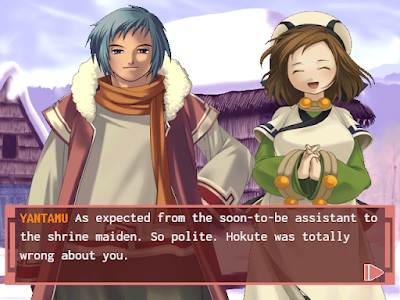Hey kids! Do you like visual novels? …What’s a visual novel, you ask? Honestly, I don’t blame you for not knowing. When it comes to video game genres, these things are nicher than even the Sega Dreamcast itself. Well, Di Gi Charat Fantasy is a visual novel, and it's the latest English fan translation project to come our way from hacker extraordinaire —and good friend of the Junkyard— Derek Pascarella, along with a team of other talented individuals.
Di Gi Charat Fantasy will be the the second officially released Dreamcast visual novel to receive an English fan translation patch, the first being Nakoruru: The Gift She Gave Me (also released by Derek et al) which received its updated 1.3 patch back in June.
Originally released exclusively in Japan on PC in early 2001, with a Dreamcast port following later that year, Di Gi Charat Fantasy presents an alternate storyline to Di Gi Charat, an anime and manga series I remember being fairly prevalent in the late-90s to early 2000s. The game was then ported to PlayStation 2 with some additional content as Di Gi Charat Fantasy Excellent. This PS2 port received an English fan translation back in October from Gopicolo, and serves as the basis for Derek's patch for Dreamcast.
Here's a little background provided by Derek on Di Gi Charat, and what you can expect from the plot of the game...
"The early anime [of Di Gi Charat] is set inside Gamers, a real retail chain in Japan that sells character goods and pop-culture media, with the main store in Akihabara. Dejiko, Puchiko, and their floating companion Gema work at Gamers, trade barbs with rival idol La Vie en Rose, and lean into running gags like Dejiko’s signature eye beam attack.
"In 'Di Gi Charat Fantasy' on Dreamcast, players will find themselves pulled from the familiar Gamers setting into Etatia, a separate fantasy world. During a spat at Gamers, Dejiko fires her eye beam, a portal opens, and the whole group is swept away. The player character wakes in a forest with Dejiko, who now has amnesia and a gentler demeanor. From there the story follows a visual novel structure with voiced scenes, character banter, and route-shaping choices as the cast explores Etatia, meets new allies and foes, and works toward restoring Dejiko’s memories and returning home."
Di Gi Charat Fantasy is a pretty standard visual novel. Lots of cutesy anime characters and text to read, with a wide variety of choices to be made that effect the direction of the narrative — with eight different character routes in total. There are also plenty of anime cutscenes in this one, so it's definitely good for existing fans of the series. Despite this, it is still accessible enough for those who haven't engaged with the franchise before.
If you fancy giving Di Gi Charat Fantasy a try, you can head over to its GitHub repository to download the patch. Instructions can be found in there on how to patch an existing GDI of the game. Another handy download that can be found in the repository is a fully completed VMU save. The game locks its "Extras" section until the player has completed all eight story routes, so this downloadable save file will give players immediate access to a cutscene gallery, a video gallery, and a music jukebox. Again, instructions can be found in the GitHub on how to transfer the save to a VMU.
I always love to see Japanese Dreamcast games get translated for English-speakers, making them accessible to a whole new audience. Let us know if you'll be giving this one a go in the comments...

















